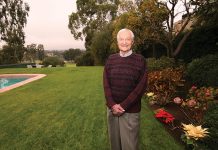For Roger Corman, it was only natural to bring assembly-line practices to Hollywood as he became king of the B pictures. By 1954, when he produced his second movie, , Corman had discovered that staying in production and making one movie after the other, while multitasking on postproduction and release, was the way to succeed.
He soon arranged a three-picture deal with American International Pictures that ensured financing for his projects. Working in every genre, he used Motor City tricks to keep the reels turning. Just as badge engineering could make a Chevrolet into an Oldsmobile, could be retrimmed to become .
Corman, now 97, enjoyed an idyllic childhood near Six Mile Road. (He has said he doesn’t remember the cross street.) He built gas-powered model planes with his younger brother, Gene, and read horror, science fiction, and adventure stories. During cold snaps, they played hockey on frozen streets. Detroit had more than 100 theaters, so there were Saturday matinees at places like the RKO Uptown at Six Mile and Woodward Avenue and the Krim on Woodward near Six Mile.
Besides the storylines of adventurer Tom Swift in novels and on the screen, two cultural narratives had emerged a few years before Corman’s birth in 1926, and they commanded the imagination of practically every Detroiter. The first developed around the legendary assembly lines of Detroit’s factories. The second came from findings of the time-and-motion studies conducted by efficiency expert Frederick Winslow Taylor and others. Efficiency was in the air like chimney smoke.
“If you couldn’t make it in the automobile industry, you came to Hollywood,” Corman told the Detroit Free Press in 2015. He was being somewhat facetious. But yes, in fact, Corman — a recent honoree at Beyond Fest, a genre film festival in Los Angeles — moved with his family to Beverly Hills, California, when he was just starting high school. He worked for the school paper at Beverly Hills High, then went to Stanford University, where he became sports editor of The Stanford Daily and studied — what else? — industrial engineering.
“[It was] a specialty that focused on efficiency and management,” he wrote in his 1998 autobiography, Never Lost a Dime. With that title, he was being facetious again. He explains in the introduction that he made or distributed “300-odd” movies and profited on “probably 280.”
After Stanford and service in the United States Navy, Corman returned to LA and went to work as a messenger at 20th Century Fox, then landed a story analyst job at $65 a week. He co-wrote the script for for $3,500. Hanging around the set during filming near the Salton Sea stirred his emotions because, as he recalled, “I felt it could have been shot more efficiently.”

Rather than artistry, Corman proclaimed craftsmanship. He engineered films with lightweight supporting structures and small casts and crews, like his model planes, and set them aloft understanding “there are very few great successes or total failures.” Wave after cinematic wave swept the country. Limited regional releases migrated within the national market, making a huge outlay for film prints unnecessary.
Corman took over directing duties and even sometimes operated the camera himself. He relied on unproven but eager newcomers like Mike Connors, star of , a story with a “contained situation,” shot in nine days for $60,000. After his first four or five movies, Corman told himself, “I can do better, more efficient work; I can make better films.”
Pouring out titles like — shot in color in two weeks for “a little under $80,000” — and — “an idea reworked to fit a low budget” — succeeded in part because of changes coming from Washington, D.C. The United States Supreme Court’s determined the Hollywood industry was a monopoly.
“They produced their films, they distributed their films, and they exhibited their films in their own chain of theaters,” explains Foster Hirsch, author of the new study , in a phone interview. “To avoid being closed altogether, they had to sell off their theaters, which meant there was no longer block booking.”
James H. Nicholson and Samuel Z. Arkoff, co-founders of , anticipated the void created when the studios couldn’t add their own B pictures to the bill. “And because the studios were in trouble, they were making fewer films, which meant there was a shortage of product,” Hirsch continues. “And so, AIP, with their double-bill turnovers, supplied product and kept downtown theaters and modest neighborhood theaters open when the majors weren’t supplying enough features for regular showings.”
Corman produced and directed a dozen movies “across a broad and amusing spectrum of themes” in 1956-57. He found no shame in low-budget filmmaking and experimented with techniques such as “shooting consecutively all the components of multiple scenes that faced in one direction in the saloon, though they were, obviously, way out of sequence. I could light one time for many setups.” Then he reversed and shot in the opposite direction. “I found that to be, perhaps, an overly efficient way to work.” The actors complained about having to perform this way.
Nevertheless, he perfected an individual style, and it sometimes delivered results on par with the auto company that turns out a commodity — say, the Pontiac Tempest — but embellishes it and creates the GTO. The list of titles speaks for itself: (principal photography in two days on a leftover stage), , , , and . New talent got a chance, too: Jack Nicholson, Charles Bronson, Robert Vaughn, Peter Fonda, Sylvester Stallone, Nancy Sinatra, Talia Shire, and Sandra Bullock.
Corman dialed back after about 50 movies and quit directing; he hired newcomers Francis Ford Coppola, Martin Scorsese, Peter Bogdanovich, John Sayles, John Landis, and Curtis Hanson (later known for ).

Corman founded his own company, New World Pictures, in 1970. Around then, Eric Saarinen received his MFA from the University of California Los Angeles’s film school. Before long, Saarinen, of the Cranbrook Saarinens, found himself in charge of second-unit photography for, produced by Corman’s wife, Julie. (“She’s a good Catholic girl — she was kind of humiliated by the subject,” Jonathan Kaplan, director of several other Corman films, said in a book about Roger.)
Saarinen continued working for the Cormans, and one Friday, he got a call to come to a hotel suite where he would be shooting a wide-angle CinemaScope camera for . Roger had acquired rights to a hit Japanese film, made big cuts, and added new dialogue for star Lorne Greene and others.
“I had never shot CinemaScope and had to learn the new camera,” Saarinen says in a phone interview. He set the lighting and served as camera operator. “They hired all these relatively famous actors to come in and play brigadier generals worried about the tidal wave. We were sandwiched into shooting in little cubbyholes and closets, trying to make it [look] big.” He estimates 30 to 40 pages of dialogue were filmed on the weekend-long shoot. “Just think about how much money he saved — and on me, too!”
Saarinen moved up to cinematographer for Eat My Dust!,Ěýthe 1976 release featuring Ron Howard that fit the young-people-on-the-run formula. “The deal was, if he stars in one, then he gets to direct one, assuming everything goes well.” Howard went on to direct Grand Theft Auto (“See the greatest cars in the world destroyed!”) and launch his directorial career.
Another Detroiter linked to Corman was the late Doug Fieger, whose first band, Sky, provided the soundtrack to (1971). Fieger later co-founded The Knack, which recorded the chart-topping hit “My Sharona” in 1979.
As sordid as his exploitation movies could be, Roger Corman was no Hugh Hefner or Harvey Weinstein.
“I met Roger,” Apollonia Kotero, co-star with Prince in the film , tells Â鶹·¬şĹ Detroit. Her uncle, the actor Dick Miller, played in Corman films Apache Woman,, The Little Shop of Horrors, , and . Kotero says of Corman, “He was a sweetheart. Roger was a great gentleman. Wish I had interned with him.”
Corman has a star on the Hollywood Walk of Fame and received an honorary Oscar. “It would be a mistake to say Roger Corman is a great film artist,” Hirsch says. “In my opinion, he is not that. But he’s other things that may in the long run be just as important.”
This story is from the February 2024 issue of Â鶹·¬şĹ Detroit magazine. Read more in our digital edition.
|
| Ěý |
|








